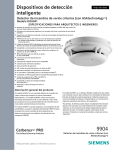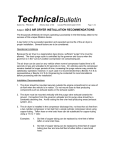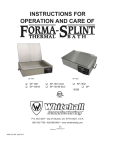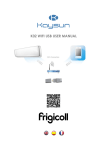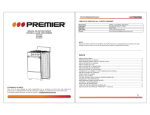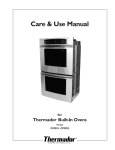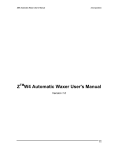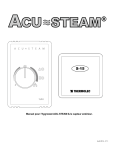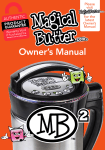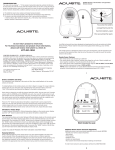Download Lochinvar s--01 User's Manual
Transcript
SSB-i&s--01 INSTALLATION AND SERVICE MANUAL SPACE SAVER BOOSTER ELECTRICAL INSTALLATION INSTRUCTIONS PLUMBING INSTALLATION INSTRUCTIONS Electric booster water heaters are available for operation on standard power systems. Check the nameplate for the proper power supply. For the most effective operation install the booster heater as close as possible to the dishwasher. All internal electrical connections have been made at the factory. See Circuit Breaker and Fuse Sizing Chart for supply wire size, fuse, breaker and conduit recommendations. NOTE: Employ recirculation if distance between booster and dishwasher exceeds NSF specifications. WARNING !! For proper electrical installation conforming to local electrical codes, consult a licensed electrical contractor. WARNING !! To assure proper operation and avoid a possible unsafe condition, the booster heater must be installed in a horizontal position with the base parallel to the floor and the inlet connection at the lowest point. WARNING !! The main power circuit must be disconnected prior to performing any maintenance on the booster heater to avoid possible personal injury or damage to the heater. TEMPERATURE AND PRESSURE RELIEF VALVE For protection against excessive pressures and temperatures in the booster heater, install temperature and pressure protective equipment required by local codes. The manufacturer supplies valves constructed with brass working parts and heat resistant silicone seat discs for all booster heater models. ELECTRICAL CONNECTIONS AL CONNECTIONS 1. Locate the heater terminal or fuse block(s) in the control box. The control box is under the front hinged jacket cover. WARNING !! 2. Bring power leads from a properly sized fused disconnect switch or circuit breaker through knock-out provided in base and connect to the terminal or fuse block(s). USE COPPER WIRE ONLY. Valves supplied by manufacturer are designed for high temperature commercial operation. Do not substitute OEM valves with valves designed for domestic water heaters. 3. A grounding lug is provided near the supply terminals. An equipment grounding conductor must be properly connected to it. Temperature/pressure protective equipment should not be less than a combination temperature/pressure relief valve certified by a nationally recognized testing laboratory that maintains periodic inspection of the production of this equipment and meets the requirements for Relief Valves and Automatic Shutoff Devices for Hot Water Supply Systems, ANSI Z21.22-latest edition. The temperature/pressure relief valve must be marked with a minimum set pressure not to exceed the marked hydrostatic test pressure of the booster heater. 4. Replace and secure cover(s). CAUTION !! Do not turn on power to booster heater until the tank has been filled with water and all air has been vented through the dishwater rinse nozzle. The heating elements will burn out in seconds if operated when they are not immersed in water, unless the heater is equipped with a low-water cutoff (LWCO). 1 TEMPERATURE/PRESSURE GAUGES CAUTION !! Manufacturer recommends a temperature/pressure gauge be installed in both the inlet and outlet lines to the booster heater. These gauges provide an instant visual check of the water temperature and pressure entering the booster heater and leaving the heater. The visual check is helpful in eliminating unnecessary service calls. For Installing Temperature and Pressure Relief Valves in accordance with American National Std. Z21-22 latest edition. Combination temperature and pressure relief valves with extension thermostats must be installed so that the temperature-sensing element is immersed in the water within the top 6" (152 mm) of the tank. They must be installed either in the hot outlet service line or directly in a tank tapping. Combination temperature and pressure relief valves that do not have extension elements must be mounted directly in a tank tapping located within the top 6" (152 mm) of the tank, and shall be adequately insulated and located so as to assure isolation from flue gas heat or other ambient conditions that are not indicative of stored water temperature. To avoid water damage or scalding due to valve operation, drain pipe must be connected to valve outlet and run to a safe place of disposal. Drain pipe must be as short as possible and be the same size as the valve discharge connection throughout its entire length. Drain line must pitch downward from the valve and terminate at least 6" (152 mm) above the floor drain where any discharge will be clearly visible. The drain line shall terminate plain, not threaded, with a material serviceable for temperatures up to 250ºF (121ºC) or greater. Excessive length, over 15' (4.57m), or use of more than two elbows can cause a restriction and reduce the discharge capacity of the valve. No shut-off valve shall be installed between the relief valve and tank, or in the drain line. Valve lever must be tripped periodically to insure that waterways are clear. This device is designated for emergency safety relief and shall not be used as an operating control. Do not use an antisiphon or check valve on the incoming water line. PLUMBING CONNECTIONS CAUTION !! To avoid development of a leak, do not back up or loosen any pipe fittings. WARNING !! Do not connect the heater directly to a boiler or furnace coil or any other uncontrolled temperature source. Such hook-up could cause the thermostat to lose control and the unit could overheat. WARNING: INLET CAUTION !! The valves are set to relieve at 150 psi or when water temperature reaches 210°F (99°C). Read tag on valve for additional information. Connect the booster heater water inlet to a hot water supply line from the regular water heater. Water temperature from the regular water heater should be 100°F or 140°F (52°C or 60°C) and should not exceed 160°F (71°C). Minimum temperature differential between inlet and outlet temperatures should never be less than 20°F (11°C). Provide the inlet line with a shut-off valve, a full open gate or ball type valve, together with a pressure reducing valve. Set pressure reducing valve at 20 psi (1.4 kg/cm2) flow pressure. PRESSURE REDUCING VALVE Proper operation of the dishwater rinse nozzles requires available water pressure at the nozzle be between 15 and 25 psi when nozzle is operated. 20 psi is recommended. NOTE: If water pressure available to the booster heater inlet is over 20 psi, a pressure reducing valve should be mounted in the hot water supply line to the booster heater. Be sure water flows through the pressure reducing valve in the proper direction. Check directional arrow. Valve will reduce pressure only during flow conditions. The pressure reducing valve supplied by the manufacturer has a built-in high pressure by-pass which prevents excessive pressure buildup as the booster heats up. A 3/4 in. union fitting and a drain valve are needed for easy servicing. 2 CAUSE B If incoming water temperature is correct and it holds through the dishwashing operation, another possible reason for this condition is that the water pressure may be too high. Water pressure to the dishwasher must be approximately 20 psi for proper operation of the booster and dishwasher rinse cycle. NOTE: Do not run a cold water line to the heater. OUTLET SOLUTION - If pressure exceeds 20 psi with the dishwasher rinse valve open, install a pressure reducing valve with built in bypass check. Using a 3/4 in. union and piping connect the booster heater water outlet to the dishwasher sanitizing rinse pipe connection. NOTE: CAUSE C The booster may be undersized. Be certain the connection is made to the final rinse and not to the wash tank. SOLUTION - Check the dishwasher model with the sizing guide to be sure the correct booster has been installed. CAUSE D The booster may have been ordered with improper voltage. Install a temperature/pressure gauge in outlet line. Water temperature at outlet should be 180°F (82°C). The temperature sensing element must be in water stream. SOLUTION - Consult specifications plate on the booster. Voltage and amperage are clearly marked. Check this information against the service to which it is connected. If heater was incorrectly specified consult factory for instructions. Manufacturer recommends a shock absorber be installed in the outlet line as close as possible to the dishwasher The shock absorber softens the water hammer caused by automatic dishwasher valves. CAUSE E A low voltage condition may exist. Low voltage is a common cause on large model heaters. INSTALLATION CHECK INSTALLATION CHECK 1. Close drain pipe valve and fill booster heater with water. SOLUTION - Verify wire size and circuit for the application. 2. Check all pipe connections for installation leaks. THE BOOSTER HEATER DOES NOT HEAT AT ALL OR ONLY DELIVERS 130-150ºF (54ºC - 66ºC) WATER. 3. Check relief valve discharge opening to be certain it is not blocked. 4. Vent air from tank before operating. CAUSE A Sometimes upon completion of an installation, the booster operation is checked by energizing the heater before the tank is completely filled with water. When elements of the immersion type are not completely covered by water at the time the heater is turned ON, the high temperature in the tank may damage the element(s) unless the unit has been equipped with a low water cut-off. CAUTION !! Leave tank filled with water during electrical hookup to prevent possible element burnout. SOLUTION - Damaged elements must be replaced. BOOSTER HEATER SERVICE PROCEDURES NOTE: Thermostats should also be inspected. Elements damaged by overheating in “dry” environment can easily damage thermostats. WATER REACHES 180ºF (82ºC), BUT DOES NOT MAINTAIN 180ºF THROUGH THE ENTIRE DISHWASHING OPERATION. CAUSE A Low incoming temperature, particularly during peak operational periods, is the most common cause of this condition. If incoming temperature is correct at the start of the dishwashing operation, check again at the end. It is possible for the supply of 140ºF (60ºC) water to be exhausted during the washing cycle. CAUSE B Fuses may be blown or circuit breaker tripped. SOLUTION - Inspect the fuses or circuit breaker and refer to data sheet for the booster model installed. If undersized fuses or circuit breakers were installed, replace with size recommended in the data sheet. See Section “Booster repeatedly blows fuses or trips circuit breakers.” SOLUTION - If incoming temperature is 140ºF (60ºC) at the start of the washing cycle, but falls below at the end, the primary water heater is not delivering sufficient 140ºF (60ºC) water and the condition is correctable with installation of a commercial primary water heater model of the correct size. Contact your representative to assure proper sizing of the primary heater. 3 (77ºC). Make certain the thermostats are set to their maximum calibration. They are pre-set at the factory to 190ºF (88ºC) to compensate for heat loss but they may have been turned down to 180ºF (82ºC) by someone overlooking heat loss through the pipes. CAUSE C Thermostats may not be functioning correctly or may be improperly set. SOLUTION - Inspect thermostats for proper operation and correct settings. If setting is below the maximum, reset to 190ºF(88ºC) If defective and not functioning, replace. SOLUTION - The booster should be moved to within 5 feet of the dishwasher if possible, and the pipes should be insulated. CAUSE D Contactors are not performing. CAUSE B Thermostats may not be functioning correctly. SOLUTION - Inspect contactors for proper operation by visual observation. Assuming no fuses are blown and power is coming to the booster, inspect the coil and replace if defective. NOTE: To help determine this cause, check rinse temperature in the dishwasher. Since the dishwasher temperature gauge could become defective, it is preferable to rely on a temperature sensitive tape or a thermometer rather than the gauge for checking this cause. CAUSE E ECO (high temperature limit switch) may be defective. SOLUTION - Check for proper operation and replace if defective. CAUSE F The fuse is blown. SOLUTION - If maximum reading is below 180ºF, (82ºC) first turn the pointers all the way up on all thermostats. If the reading is still below 180ºF (82ºC), minor adjustments can be made on the thermostats. If recalibration does not help, the thermostat is defective and should be replaced. SOLUTION - Replace fuse. If fuse continues to blow, either a contactor coil is defective, or the booster control transformer is defective. If booster has more than one contactor, disconnect wires so only one contactor at a time is energized. The defective one can then be isolated and replaced. BOOSTER HEATER REPEATEDLY BLOWS FUSES OR TRIPS CIRCUIT BREAKERS. On all boosters with low water cut-off, the following trouble shooting procedures apply. NOTE: CAUSE G Relay does not pull in after booster is filled with water and air bled out. Fuses or circuit breakers should not be loaded to more than 80% of their rating. SOLUTION CAUSE A Fuses are undersized-too small to carry the load. 1. Check for voltage at line terminals 1 and 2 using volt-meter or test light. If there is no voltage, refer to CAUSE F. SOLUTION - Check “Fuse and Disconnect Switch Sizes” table for recommended sizes. Replace undersized fuses with correct one. 2. Open circuit between ground and the probe. Check for broken wire or poor contact at connections. To test, run temporary wires from probe terminal #3. If relay pulls in, the wire is broken and should be replaced. CAUSE B Short circuit in internal heater wiring. 3. Check or open relay coils. With line voltage applied at 1 and 2, connect a jumper wire between 6 and 7. Relay should pull in when the jumper is connected and fall out when the jumper is removed. Failure to do so indicates one of the coils is open and the relay should be replaced. SOLUTION - By visual inspection check for: loose connections, grounded heating elements, frayed insulation and foreign matter touching wiring terminals. WHEN THE DISHWASHER AND THE BOOSTER HAVE BEEN IDLE FOR SEVERAL HOURS, RELIEF VALVE OPENS OR ECO TRIPS. 4. Fouled probe. If solution 2 discloses no broken wire or poor connection and relay still does not pull in, probe tip may be insulated by lime buildup. If relay operates when a jumper wire is connected between terminals 3 and ground, the probe is fouled. Remove probe and clean the electrode. CAUSE A A cause of overheating and resulting relief is excessive primary water temperature. Primary water temperature should not exceed 160ºF (71ºC). TEMPERATURE REACHES ONLY 170-175ºF (77ºC - 79ºC). THIS CONDITION AS DIFFERENTIATED FROM CONDITION II INDICATES THE BOOSTER HEATER IS FUNCTIONING, BUT MAY NOT BE REACHING PROPER TEMPERATURE (180ºF, 82ºC). SOLUTION - Check to be sure primary water heater is functioning properly. Primary water heater thermostats may be set too high, causing nuisance tripping. Adjust primary heater thermostats to 140-150ºF (60ºC - 66ºC). CAUSE A Booster should be close to the dishwasher, (5 feet or less). If the booster is more than 5 feet away, the heat loss through the pipes is the most likely reason the dishwasher thermometer reads only 170ºF 4 CAUSE B Control thermostat may be set too high or be defective. CAUTION !! Do not overtighten nut, or sleeve inside of bushing will cut through tubing. SOLUTION - Reset thermostat(s). If condition is not corrected, replace thermostat(s). CHATTERING CONTACTOR(S) OR NOISY RELAY. 4. CAUSE A Contactors chatter or hum excessively when pulled in. SOLUTION - Accumulation of dirt will prevent proper seating of armature. Remove contactor and clean. If proper seating is prevented by warpage of the frame or distorted coil, contactor should be replaced. Check for loose connections or wire connections with insulation under crimp. CAUTION !! Be sure tank is filled with water before turning on power. CAUSE B Contactors chatter only at pull-in or drop-out, or low water cutoff relay is noisy. SOLUTION - Check for low voltage at control circuit and at secondary side of transformer. If voltage is below 120 volts, replace transformer. Low water cutoff probe may be fouled. To check, remove wire from LWCO probe and ground to tank. If LWCO board relay pulls in and stops chattering, the probe is fouled. To clean, drain water from tank, remove probe and clean probe tip. THERMOSTAT ADJUSTMENT AND RECALIBRATION The thermostats are factory calibrated to produce 185-190ºF (85-88ºC) temperatures. If recalibration is necessary, turn screw (G) counterclockwise to lower the set point or turn the adjustment nut (F) counterclockwise to raise the set point (must hold screw (G) at high stop). NOTE: one-sixth of a turn equals 12ºF (6.7ºC). These thermostats are checked and accurately set at out factory. If recalibration is necessary, a 1/4 turn clockwise to screw (F) will decrease the temperature 12ºF (6.7ºC). REMOVAL 1. 2. Shut off power and drain tank; remove leads from terminals (E). Loosen nut (A), then remove bushing (B) from tank. Thermostat with bracket and sensor bulb (C) can now be removed from tank. INSTALLATION 1. 2. 3. Replace thermostat on bracket. Replace leads on thermostat terminals. Pull end of sensor bulb (C) into recess in bushing (B). Insert bushing (B) and sensor bulb into tank; holding sensor bulb in place with capillary tube, tighten bushing (B). Lock sensor bulb and capillary tube in place by tightening nut (A). 5 HIGH TEMPERATURE LIMIT SWITCH RECALIBRATION If the temperature in the heater exceeds 210ºF (99ºC), the high temperature limit will shut off the power. The switches must be manually reset by pushing the red buttons. The limit switch has been calibrated at the factory and should not require adjusting. If the calibration changes and must be re-adjusted, the procedure is as follows: Models 4-18kW Hold lock nut (F) and turn calibrating screw (G) clockwise 1/8 turn to increase set point 7ºF (3.9ºC), or hold screw (G) and turn nut (F) clockwise. Model 24 - 58kW Turn adjustable screw (D) clockwise to raise set point - 1/8 turn equals about 7ºF (3.9ºC). REMOVAL 1. 2. 3. Shut off power and drain tank; remove leads from terminals (E). Remove two screws holding the switch on the bracket. Loosen nut (A), then remove bushing (B) from tank. The high limit switch and sensor bulb (C) can now be removed from tank. INSTALLATION 1. 2. 3. Pull end of sensor bulb (C) into recess in bushing (B). Insert bushing (B) and sensor bulb into tank; holding sensor bulb in place with capillary tube, tighten bushing (B). Lock sensor bulb and capillary tube in place by tightening nut (A). CAUTION !! Do not overtighten nut, or sleeve inside of bushing will cut through tubing. 4. Replace switch on bracket. Replace leads on terminals. CAUTION !! Be sure tank is filled with water before turning on power. 6 CIRCUIT BREAKER AND FUSED DISCONNECT SWITCH SIZES kW 6 9 12 15 18 24 30 36 45 54 58 VOLTS 208 208 240 240 480 208 208 240 240 480 208 208 240 240 480 208 208 240 240 480 208 208 240 240 480 208 208 240 240 480 208 208 240 240 480 208 208 240 240 480 208 240 240 480 208 240 480 208 240 480 PH 1 3 1 3 3 1 3 1 3 3 1 3 1 3 3 1 3 1 3 3 1 3 1 3 3 1 3 1 3 3 1 3 1 3 3 1 3 1 3 3 3 1 3 3 3 3 3 3 3 3 L1 29 14 25 13 6 43 22 38 19 9 58 33 50 29 14 72 42 63 36 18 87 48 75 43 22 115 67 100 58 30 144 83 125 72 36 173 100 150 87 43 125 188 108 54 150 130 65 162 141 71 L2 29 25 25 22 11 43 38 38 33 16 58 33 50 29 14 72 42 63 36 18 87 48 75 43 22 115 67 100 58 30 144 83 125 72 36 173 100 150 87 43 125 188 108 54 150 130 65 162 141 71 L3 — 14 — 13 6 — 22 — 19 9 — 33 — 29 14 — 42 — 36 18 — 48 — 43 22 — 67 — 58 30 — 83 — 72 36 — 100 — 87 43 125 — 108 54 150 130 65 162 141 71 Breaker or Fuse Size Copper Wire Size 40 8 40 8 40 8 30 10 15 14 60 6 50 8 50 8 50 8 20 12 90 3 50 8 70 4 40 8 20 12 90 3 60 6 90 3 50 8 30 10 125 1 60 6 100 3 60 6 30 10 150 1/0 90 3 125 1 90 3 40 8 200 3/0 125 3 175 2/0 100 3 50 8 225 4/0 125 1 200 3/0 125 1 60 6 175 2/0 250 250 MCM 150 1/0 70 4 200 3/0 175 2/0 90 3 225 4/0 200 3/0 90 3 Conduit Size 1/2” 3/4” 1/2” 1/2” 1/2” 3/4” 3/4” 1/2” 3/4” 1/2” 1” 3/4” 1” 3/4” 1/2” 1” 3/4” 1” 3/4” 1/2” 1-1/4” 3/4” 1” 3/4” 1/2” 1-1/4” 1-1/4” 1-1/4” 1-1/4” 3/4” 1-1/2” 1-1/2” 1-1/2” 1-1/4” 3/4” 2” 1-1/2” 1-1/2” 1-1/2” 3/4” 2” 2” 1-1/2” 1” 1-1/2” 2” 1-1/4” 2” 1-1/2” 1-1/4” Wire size is based on THHN wire for branch circuit protection at .91 derate factor. Circuit breakers are to be mounted remotely and wired by the contractor. Sizes are based on the NEC table 310-16. Conduit size is based on conductors plus ground wire sizing as per NEC table 250-122. 7 DIMENSIONS HANGING SUPPORT 8 PLUMBING CONNECTIONS 9 10 11 CP-2M-4/03-Printed in U.S.A.












